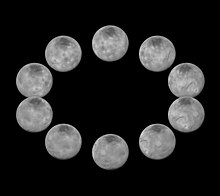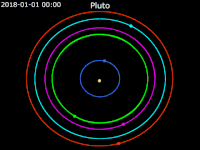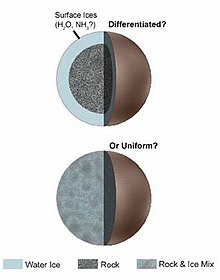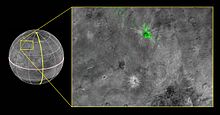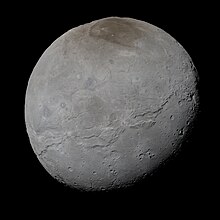
Charon in true color, imaged by New Horizons
| |
| Discovery | |
|---|---|
| Discovered by | James W. Christy |
| Discovery date | 22 June 1978 |
| Designations | |
| Pronunciation | /ˈʃærən/ SHARR-ən or /ˈkɛərən/ KAIR-ən |
Named after
| Charon |
| (134340) Pluto I | |
| Adjectives | Charonian |
| Orbital characteristics | |
| Epoch 2452600.5 (2002 Nov 22) | |
| Periapsis | 17,536 km |
| Apoapsis | 17,536 km |
| 19591km | |
| Eccentricity | 0.0002 |
| 6.3872304±0.0000011 d (6 d, 9 h, 17 m, 36.7 ± 0.1 s) | |
Average orbital speed
| 0.21 km/s |
| Inclination | 0.080° (to Pluto's equator) 119.591°±0.014° (to Pluto's orbit) 112.783°±0.014° (to the ecliptic) |
| 223.046°±0.014° (to vernal equinox) | |
| Satellite of | Pluto |
| Physical characteristics | |
Mean radius
| 606.0±0.5 km (0.095 Earths, 0.51 Plutos) |
| Flattening | <0 .5="" nbsp="" span=""> |
| 4.6×106 km2 (0.0090 Earths) | |
| Volume | (9.32±0.14)×108 km3 (0.00086 Earths) |
| Mass | (1.586±0.015)×1021 kg (2.66×10−4 Earths) (12.2% of Pluto) |
Mean density
| 1.702±0.017 g/cm3 |
| 0.288 m/s2 | |
| 0.59 km/s 0.37 mi/s | |
| synchronous | |
| Albedo | 0.2 to 0.5 at a solar phase angle of 15° |
| Temperature | −220 °C (53 K) |
| 16.8 | |
| 1 | |
| 55 milli-arcsec | |
Charon, also known as (134340) Pluto I, is the largest of the five known natural satellites of the dwarf planet Pluto. It has a mean radius of 606 km. It was discovered in 1978 at the United States Naval Observatory in Washington, D.C., using photographic plates taken at the United States Naval Observatory Flagstaff Station (NOFS).
With half the diameter and one eighth the mass of Pluto, Charon is a very large moon in comparison to its parent body. Its gravitational influence is such that the barycenter of the Plutonian system lies outside Pluto.
The reddish-brown cap of the north pole of Charon is composed of tholins; organic macromolecules that may be essential ingredients of life. These tholins were produced from methane, nitrogen and related gases released from the atmosphere of Pluto and transferred over 19,000 km (12,000 mi) to the orbiting moon.
The New Horizons spacecraft is the only probe that has visited the Pluto system. It approached Charon to within 27,000 km (17,000 mi) in 2015.
Discovery
Charon's discovery at the Naval Observatory
Flagstaff Station as a time-varying bulge on the image of Pluto (seen
near the top at left, but absent on the right). Negative image.
Mosaic of best-resolution images of Charon from different angles
Charon was discovered by United States Naval Observatory astronomer James Christy, using the 1.55-meter (61 in) telescope at United States Naval Observatory Flagstaff Station (NOFS), On June 22, 1978, he had been examining highly magnified images of Pluto on photographic plates
taken with the telescope two months prior. Christy noticed that a
slight elongation appeared periodically. The bulge was confirmed on
plates dating back to April 29, 1965. The International Astronomical Union formally announced Christy's discovery to the world on July 7, 1978.
Subsequent observations of Pluto determined that the bulge was
due to a smaller accompanying body. The periodicity of the bulge
corresponded to Pluto's rotation period, which was previously known from
Pluto's light curve. This indicated a synchronous orbit,
which strongly suggested that the bulge effect was real and not
spurious. This resulted in reassessments of Pluto's size, mass, and
other physical characteristics because the calculated mass and albedo of the Pluto–Charon system had previously been attributed to Pluto alone.
Doubts about Charon's existence were erased when it and Pluto entered a five-year period of mutual eclipses and transits between 1985 and 1990. This occurs when the Pluto–Charon orbital plane
is edge-on as seen from Earth, which only happens at two intervals in
Pluto's 248-year orbital period. It was fortuitous that one of these
intervals happened to occur soon after Charon's discovery.
Name
Author Edmond Hamilton referred to three moons of Pluto in his 1940 science fiction novel Calling Captain Future, naming them Charon, Styx, and Cerberus.
After its discovery, Charon was originally known by the temporary designation S/1978 P 1, according to the then recently instituted convention. On June 24, 1978, Christy first suggested the name Charon as a scientific-sounding version of his wife Charlene's nickname, "Char". Although colleagues at the Naval Observatory proposed Persephone, Christy stuck with Charon after discovering that it coincidentally refers to a Greek mythological figure: Charon (/ˈkɛərɒn/ or /ˈkɛərən/; Greek Χάρων) is the ferryman of the dead, closely associated in myth with the god Hades, whom the Romans identified with their god Pluto. The IAU officially adopted the name in late 1985 and it was announced on January 3, 1986.
There is minor debate over the preferred pronunciation of the
name. The practice of following the classical pronunciation established
for the mythological ferryman Charon (IPA [ˈkɛ:rən]) is used by major English-language dictionaries, such as the Merriam-Webster and Oxford English Dictionary.
These indicate only one pronunciation of "Charon" when referring
specifically to Pluto's moon: with an initial "k" sound. Speakers of
many languages other than English, and many English-speaking astronomers
as well, follow this pronunciation.
However, Christy himself pronounced the ch as sh (IPA [ʃ]), after his wife Charlene. Because of this, as an acknowledgement of Christy and sometimes as an in-joke or shibboleth, the initial sh pronunciation is common among astronomers when speaking English, and this is the prescribed pronunciation at NASA and of the New Horizons team.
Formation
Simulation work published in 2005 by Robin Canup suggested that Charon could have been formed by a collision around 4.5 billion years ago, much like Earth and the Moon. In this model, a large Kuiper belt object struck Pluto at high velocity, destroying itself and blasting off much of Pluto's outer mantle, and Charon coalesced from the debris.
However, such an impact should result in an icier Charon and rockier
Pluto than scientists have found. It is now thought that Pluto and
Charon might have been two bodies that collided before going into orbit
about each other. The collision would have been violent enough to boil
off volatile ices like methane (CH
4) but not violent enough to have destroyed either body. The very similar density of Pluto and Charon implies that the parent bodies were not fully differentiated when the impact occurred.
4) but not violent enough to have destroyed either body. The very similar density of Pluto and Charon implies that the parent bodies were not fully differentiated when the impact occurred.
Orbit
Animation of moons of Pluto around the barycenter of Pluto:
Pluto · Charon · Styx · Nix · Kerberos · Hydra
A view of the Pluto–Charon system showing that Pluto orbits a point outside itself. Also visible is the mutual tidal locking between the two bodies.
Charon and Pluto orbit each other every 6.387 days. The two objects are gravitationally locked
to one another, so each keeps the same face towards the other. This is a
case of mutual tidal locking, as compared to that of the Earth and the
Moon, where the Moon always shows the same face to Earth, but not vice
versa. The average distance between Charon and Pluto is 19,570
kilometres (12,160 mi). The discovery of Charon allowed astronomers to
calculate accurately the mass of the Plutonian system, and mutual occultations
revealed their sizes. However, neither indicated the two bodies'
individual masses, which could only be estimated, until the discovery of
Pluto's outer moons in late 2005. Details in the orbits of the outer
moons revealed that Charon has approximately 12% of the mass of Pluto.
Physical characteristics
Charon's diameter is 1,212 kilometres (753 mi), just over half that of Pluto, and larger than the dwarf planet Ceres, and the twelfth largest natural satellite in the solar system. Charon is sufficiently massive to have collapsed
into a spheroid under its own gravity. Charon's slow rotation means
that there is almost no flattening. Its equatorial and polar radii
differ by less than 1%.
Interior
The two conflicting theories about Charon's internal structure
Charon's volume and mass allow calculation of its density, 1.702±0.017 g/cm3,
from which it can be determined that Charon is slightly less dense than
Pluto and suggesting a composition of 55% rock to 45% ice (± 5%),
whereas Pluto is about 70% rock. The difference is considerably lower
than that of most suspected collisional satellites. Before New Horizons'
flyby, there were two conflicting theories about Charon's internal
structure: some scientists thought Charon to be a differentiated body
like Pluto, with a rocky core and an icy mantle, whereas others thought
it would be uniform throughout. Evidence in support of the former position was found in 2007, when
observations by the Gemini Observatory of patches of ammonia hydrates
and water crystals on the surface of Charon suggested the presence of
active cryogeysers. The fact that the ice was still in crystalline form
suggested it had been deposited recently, because solar radiation would
have degraded it to an amorphous state after roughly thirty thousand years.
Surface
Charon in enhanced color to bring out differences in surface composition.
Unlike Pluto's surface, which is composed of nitrogen and methane ices, Charon's surface appears to be dominated by the less volatile water ice. In 2007, observations by the Gemini Observatory of patches of ammonia hydrates and water crystals on the surface of Charon suggested the presence of active cryogeysers and cryovolcanoes.
Photometric mapping of Charon's surface shows a latitudinal trend in albedo,
with a bright equatorial band and darker poles. The north polar region
is dominated by a very large dark area informally dubbed "Mordor" by the New Horizons team. The favored explanation for this phenomenon is that they are formed by condensation of gases that escaped from Pluto's atmosphere.
In winter, the temperature is −258 °C, and these gases, which include
nitrogen, carbon monoxide, and methane, condense into their solid forms;
when these ices are subjected to solar radiation, they chemically react
to form various reddish tholins.
Later, when the area is again heated by the Sun as Charon's seasons
change, the temperature at the pole rises to −213 °C, resulting in the
volatiles sublimating and escaping Charon, leaving only the tholins
behind. Over millions of years, the residual tholin builds up thick
layers, obscuring the icy crust. In addition to Mordor, New Horizons found evidence of extensive past geology that suggests that Charon is probably differentiated;
in particular, the southern hemisphere has fewer craters than the
northern and is considerably less rugged, suggesting that a massive
resurfacing event—perhaps prompted by the partial or complete freezing
of an internal ocean—occurred at some point in the past and removed many
of the earlier craters.
Charon has a series of extensive grabens or canyons, such as Serenity Chasma, which extend as an equatorial belt for at least 1000 km. Argo Chasma potentially reaches as deep as 9 km, with steep cliffs that may rival Verona Rupes on Miranda for the title of tallest cliff in the solar system.
Organa, the youngest crater of Charon.
Mountain in a moat
In a released photo by New Horizons, an unusual surface
feature has captivated and baffled the scientist team of the mission.
The image reveals a mountain rising out of a depression. It's "a large
mountain sitting in a moat", said Jeff Moore, of NASA’s Ames Research Center, in a statement. "This is a feature that has geologists stunned and stumped", he added. New Horizons captured the photo from a distance of 49,000 miles (79,000 km).
Observation and exploration
Since the first blurred images of the moon (1), images showing Pluto and Charon resolved into separate disks were taken for the first time by the Hubble Space Telescope in the 1990s (2).
The telescope was responsible for the best, yet low quality images of
the moon. In 1994, the clearest picture of the Pluto-Charon system
showed two distinct and well defined circles (3). The image was taken by Hubble's Faint Object Camera (FOC) when the system was 2.6 billion miles (4.4 billion kilometers) away from Earth Later, the development of adaptive optics made it possible to resolve Pluto and Charon into separate disks using ground-based telescopes.
In June 2015, the New Horizons
spacecraft captured consecutive images of the Pluto–Charon system as it
approached it. The images were put together in an animation. It was the
best image of Charon to that date (4). In July 2015, the New Horizons
spacecraft made its closest approach to the Pluto system. It is the
only spacecraft to date to have visited and studied Charon. Charon's
discoverer James Christy and the children of Clyde Tombaugh were guests at the Johns Hopkins Applied Physics Laboratory during the New Horizons closest approach.
Classification
The center of mass
(barycenter) of the Pluto–Charon system lies outside either body.
Because neither object truly orbits the other, and Charon has 12.2% the
mass of Pluto, it has been argued that Charon should be considered to be
part of a binary system with Pluto. The International Astronomical Union
(IAU) states that Charon is considered to be just a satellite of Pluto,
but the idea that Charon might be classified a dwarf planet in its own
right may be considered at a later date.
In a draft proposal for the 2006 redefinition
of the term, the IAU proposed that a planet be defined as a body that
orbits the Sun that is large enough for gravitational forces to render
the object (nearly) spherical. Under this proposal, Charon would have
been classified as a planet, because the draft explicitly defined a
planetary satellite as one in which the barycenter lies within the major
body. In the final definition, Pluto was reclassified as a dwarf planet,
but the formal definition of a planetary satellite was not decided
upon. Charon is not in the list of dwarf planets currently recognized by
the IAU. Had the draft proposal been accepted, even the Moon would be classified as a planet in billions of years when the tidal acceleration
that is gradually moving the Moon away from Earth takes it far enough
away that the center of mass of the system no longer lies within Earth.
The other moons of Pluto, Nix, Hydra, Kerberos and Styx,
orbit the same barycenter, but they are not large enough to be
spherical, and they are simply considered to be satellites of Pluto (or
of Pluto–Charon).
Videos
Charon – Flyover video animation

